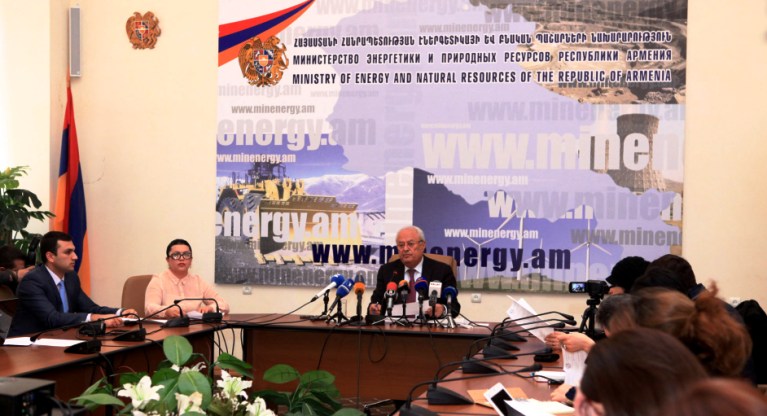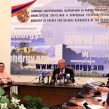
Planned Electricity Fee Increase May Revive Protest Movement in Armenia
Publication: Eurasia Daily Monitor Volume: 12 Issue: 110
By:

In early May, the Electric Networks of Armenia (ENA) joint-stock company (a subsidiary of Russian RAO UES International) submitted a request to Armenia’s state regulatory commission for a fee increase for retail customers. Currently, there is a two-tier price system, with 42 Armenian dram (about 9 cents—1 US dollar equals 477 Armenian dram) per kilowatt-hour (kWh) consumed between 7 a.m. and 11 p.m., and 32 dram per kilowatt-hour between 11 p.m. and 7 a.m. ENA’s recent request suggested a fee increase of an extra 17 dram per kWh. ENA is a monopolist and holds an exclusive license to distribute electricity in Armenia. Since 2006, when ENA was acquired by RAO UES, the state regulatory commission already approved three requests for fee increases, and the current price has been in place since August 2014 (Hetq.am, May 12). Remarkably, despite the large proportion of electricity being generated by gas-burning power plants, the latest increase occurred after signing an agreement with Russia in December 2013, which guaranteed Gazprom’s monopoly as natural gas supplier to Armenia for 30 years in exchange for a five-year price discount. At the same time, the Armenian government rejected Iran’s offer to supply gas more cheaply than Russia (see EDM, February 2).
ENA’s managers explained the request by pointing to the company’s low profitability and collected debts, which have resulted in overall losses. Armenia’s Energy Minister Yervand Zakharyan noted already in January that because of the poor management of its funds, ENA owed 15.8 billion dram ($33.1 million) to state structures and supplying companies and more than $220 million to banks. Therefore, ENA’s current fees could have been insufficient (Minenergy.am, January 14). Recently, Zakharyan again stated that a fee increase would be justified (News.am, May 13).
However, the ENA managers’ explanations about low profitability seem suspect: a report published by RAO UES shows a clear increase in the revenue received from Armenia. In the first quarter of 2015, the company’s revenue amounted to 5.7 billion Russian rubles ($104 million), compared to 3.45 billion rubles ($60 million) in the first quarter of 2014. Accordingly, earnings before interest, taxes, depreciation and amortization (EBITDA) increased and amounted to 681 million rubles ($12.3 million), compared to 123 million ($2.23 million) in 2014 (Interrao.ru, May 28). Moreover, Deputy Minister of Energy Areg Galstyan recently revealed that Armenia’s Metsamor Nuclear Power Plant, which covers nearly 40 percent of the country’s electricity generation, sells power to ENA for 5.73 dram (1.2 cents) per kWh (News.am, April 29). Additionally, the price of natural gas in Armenia has not grown since 2013. Therefore, complaints about losses suffered by ENA do not seem justified.
It has also been revealed that ENA has been paying, on average, about 20 percent above market price for equipment, cables and other materials acquired since 2013, and about 14 percent above market price for services supplied by contractor companies (Hetq.am, May 12). Armenia’s bar association member Nikolay Baghdasaryan noted that since state officials admit that ENA’s funds have been misappropriated, they should not support the company’s managers’ request for a fee increase but rather demand a criminal investigation (Gala TV, May 17). A Transparency International expert also noted that ENA’s expenditures structure, including not only the acquisition of supplies, but salaries, travel and other costs, is not transparent (Aravot.am, June 4).
ENA General Manager Yevgeny Bibin attempted to justify the company’s price hike demand during a meeting with members of the parliamentary faction of the ruling Republican Party of Armenia. After that meeting, he left in a hurry, pushing aside journalists who attempted to ask him questions (Henaran.am, June 3). A session of the parliament’s standing committee on economic affairs resulted in a scandal, as the committee’s chair insulted an opposition parliamentarian who demanded to file an official complaint to the prosecutor general concerning the revealed misappropriation of ENA’s funds (Aravot.am, June 5). Another parliamentary hearing was scheduled for June 12.
Significantly, a protest rally on May 27, organized by civic activists, gathered more participants than the parliamentary opposition’ last protest campaign in October 2014. An increase in electricity prices would cause a chain reaction resulting in general price inflation. Thus, this is an issue that could potentially unite a larger part of the population than the current agendas of Armenia’s political parties. The failure to modernize the country’s infrastructure, despite all previous instances of raised fees and the overall poor quality of service—with a number of blackouts in recent years—have further added to popular discontent. Finally, the public’s anger is exacerbated by the authorities’ unwillingness to investigate citizens’ complaints about the manipulation of electrical meters by ENA’s employees, resulting in higher electricity bills, as well as the more recent unwillingness by the government to investigate financial matters related to ENA’s expenditures.
According to some commentators, the state regulatory commission will likely end up approving a fee increase for electricity. But in order to avoid public protests and allow some measure of “saving face” for ENA’s Russian managers, the fee increase would be smaller than requested by the utility company. The state regulatory commission’s chair, Robert Nazaryan, hinted about such a possibility, telling journalists that some price increase would be justified (Azatutyun.am, June 2). Wary of displeasing the Russians, Armenian officials will probably not consider filing a bankruptcy case against ENA, which would be a logical solution to this outstanding problem.
So far, Armenian officials’ habitual servile attitude toward the Russians has been paid for by Armenia’s ordinary citizens. Russian ownership of Armenia’s gas and electricity supply and distribution networks has not resulted in the discounts or higher quality of services that were expected by Russia’s loyalists. Rather, it appears to have led to profiteering at the expense of the country’s population. Despite the “strategic partnership” and “brotherhood” narratives, Armenian households pay the highest electricity fees in the post-Soviet space, and household gas prices exceed even the costs paid by consumers in Ukraine—a country that is, in fact, currently at war against Russia—and in some European Union member states. It remains to be seen if larger protests will follow. But such a possibility should not be excluded if an electricity fee increase takes place.




